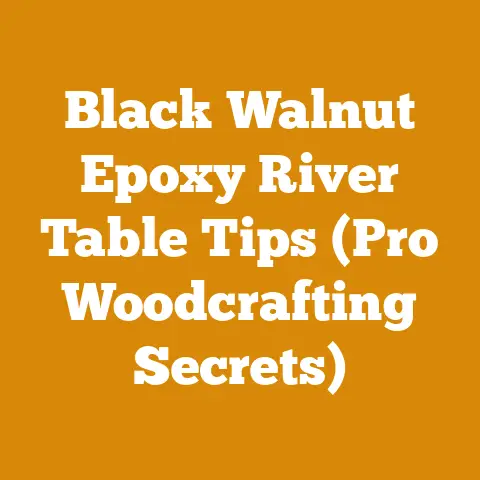Forester Fireplace Insert Guide (5 Pro Tips for Optimal Woodburn)
I’m here to tell you that that’s simply not true. I’ve spent years learning the ins and outs of woodburning, and the key to optimal performance and safety lies in understanding the nuances of wood selection, preparation, and burning techniques. Today, I’m going to share five pro tips that will transform your experience with your Forester fireplace insert, ensuring efficient heating, minimal emissions, and a cozy ambiance that you can rely on.
Forester Fireplace Insert Guide: 5 Pro Tips for Optimal Woodburn
Why Your Woodburning Habits Matter
Before we dive into the specific tips, let’s take a moment to understand why these practices are so important. An inefficient woodburning setup can lead to a host of problems, including:
- Poor Heat Output: Wet or improperly seasoned wood burns cooler, meaning you’ll need to use more wood to achieve the same level of warmth.
- Excessive Smoke and Emissions: Incomplete combustion releases harmful pollutants into the air, impacting both your health and the environment.
- Creosote Buildup: This flammable substance accumulates in your chimney, increasing the risk of a dangerous chimney fire.
- Damage to Your Fireplace Insert: Overfiring or using the wrong type of wood can warp or crack the firebox, leading to costly repairs.
With the right knowledge and techniques, you can avoid these pitfalls and enjoy the full benefits of your Forester fireplace insert.
Pro Tip #1: Master the Art of Wood Selection
Choosing the right type of wood is the foundation of efficient and safe woodburning. Not all wood is created equal, and understanding the differences between hardwoods and softwoods is crucial.
Hardwood vs. Softwood: A Deep Dive
- Hardwoods: These woods come from deciduous trees (trees that lose their leaves in the fall) like oak, maple, ash, and birch. They are denser than softwoods, meaning they contain more energy per unit volume. Hardwoods burn hotter and longer, producing more consistent heat.
- Softwoods: These woods come from coniferous trees (trees that have needles and cones) like pine, fir, and spruce. They are less dense than hardwoods and tend to burn faster and hotter, producing more smoke and creosote.
While hardwoods are generally preferred for woodburning, softwoods can be used effectively if you understand their limitations. I often use softwoods for starting fires or when I need a quick burst of heat, but I always rely on hardwoods for sustained burning.
Understanding Wood Density and BTU Value
The density of wood is directly related to its BTU (British Thermal Unit) value, which measures the amount of heat released when the wood is burned. Here’s a comparison of the approximate BTU values per cord (a stack of wood measuring 4 feet high, 4 feet wide, and 8 feet long) for common wood species:
| Wood Species | Approximate BTU Value per Cord |
|---|---|
| Oak | 24-30 million BTU |
| Maple | 20-25 million BTU |
| Ash | 20-24 million BTU |
| Birch | 20-24 million BTU |
| Pine | 15-20 million BTU |
| Fir | 15-18 million BTU |
| Spruce | 12-16 million BTU |
As you can see, hardwoods like oak and maple offer significantly more heat per cord than softwoods like pine and spruce. This means you’ll need to burn less hardwood to achieve the same level of warmth, saving you time and money in the long run.
My Personal Experience with Wood Selection
I remember one winter when I was running low on seasoned oak and decided to burn a large quantity of pine that I had readily available. I quickly realized that I was constantly feeding the fire, and the heat output was nowhere near what I was used to. The chimney also required more frequent cleaning due to the increased creosote buildup. That experience taught me the importance of prioritizing hardwoods and using softwoods sparingly.
Actionable Tip:
Identify the common tree species in your area and research their BTU values. Focus on sourcing hardwoods whenever possible, and reserve softwoods for kindling or short-term heating needs.
Pro Tip #2: Season Your Wood Like a Pro
Seasoning wood is the process of drying it to reduce its moisture content. Freshly cut wood can contain as much as 50% moisture, which significantly reduces its burning efficiency and increases smoke production. Properly seasoned wood should have a moisture content of 20% or less.
The Science of Wood Seasoning
When you burn wet wood, a significant portion of the heat energy is used to evaporate the water, rather than heating your home. This process cools the fire, leading to incomplete combustion and increased smoke. Seasoning allows the water to evaporate naturally, resulting in a hotter, cleaner burn.
How to Season Wood Effectively
- Split the Wood: Splitting the wood exposes more surface area, allowing it to dry faster.
- Stack the Wood Properly: Stack the wood in a single row, allowing air to circulate freely around each piece. Elevate the wood off the ground using pallets or scrap lumber to prevent moisture from wicking up from the soil.
- Choose a Sunny and Windy Location: Sunlight and wind promote evaporation, accelerating the drying process.
- Cover the Top of the Stack: A tarp or roof can protect the wood from rain and snow, preventing it from reabsorbing moisture. However, leave the sides of the stack open to allow for ventilation.
- Be Patient: Seasoning takes time. Hardwoods typically require 6-12 months to season properly, while softwoods may be ready in as little as 3-6 months.
Measuring Moisture Content
The most accurate way to determine if your wood is properly seasoned is to use a moisture meter. These devices measure the electrical resistance of the wood, which is directly related to its moisture content. Simply insert the probes of the meter into a freshly split piece of wood, and the meter will display the moisture percentage.
My Seasoning Setup
I have two separate woodpiles: one for wood that is currently seasoning and another for wood that is ready to burn. I always split and stack my wood in the spring, giving it ample time to dry before the heating season begins. I also use a moisture meter to ensure that the wood is properly seasoned before I bring it indoors.
Actionable Tip:
Invest in a moisture meter and use it regularly to monitor the moisture content of your wood. Aim for a moisture content of 20% or less for optimal burning.
Pro Tip #3: Master the Art of Fire Starting and Management
Starting and maintaining a fire in your Forester fireplace insert requires a bit of finesse. Here are some techniques that I’ve found to be particularly effective:
The Top-Down Fire Method
This method involves building the fire upside down, with the kindling and tinder placed on top of the larger logs. This allows the fire to burn downwards, producing less smoke and more consistent heat.
- Place two or three large logs at the bottom of the firebox.
- Arrange a layer of smaller logs perpendicular to the bottom logs.
- Place a layer of kindling on top of the smaller logs.
- Top the kindling with tinder, such as newspaper, dry leaves, or commercial fire starters.
- Light the tinder and allow the fire to burn downwards.
The Traditional Teepee Method
This method involves arranging the kindling and tinder in a cone shape, with the larger logs placed around the outside. This allows for good airflow and rapid ignition.
- Place a small pile of tinder in the center of the firebox.
- Arrange the kindling around the tinder in a cone shape.
- Light the tinder and allow the kindling to catch fire.
- Gradually add larger logs to the fire, maintaining good airflow.
Controlling Airflow for Optimal Burning
Your Forester fireplace insert has air controls that allow you to regulate the amount of oxygen that enters the firebox. Adjusting the airflow can significantly impact the efficiency and intensity of the fire.
- More Air: Increased airflow results in a hotter, faster-burning fire. This is useful for starting a fire or when you need a quick burst of heat.
- Less Air: Reduced airflow results in a slower, more controlled burn. This is ideal for maintaining a consistent heat output over a longer period.
Experiment with the air controls to find the optimal settings for your specific wood type and heating needs.
My Fire Starting Routine
I always start my fires using the top-down method, as I find it to be the most efficient and clean-burning. I use a combination of newspaper, dry twigs, and small pieces of kindling to get the fire going. Once the fire is established, I gradually add larger logs, adjusting the airflow to maintain a consistent heat output.
Actionable Tip:
Experiment with different fire starting methods and airflow settings to find what works best for your Forester fireplace insert and your specific wood type.
Pro Tip #4: Prioritize Fireplace Insert Maintenance and Safety
Regular maintenance is essential for ensuring the safe and efficient operation of your Forester fireplace insert. Here are some key maintenance tasks to perform:
Chimney Cleaning
Creosote buildup in the chimney is a major fire hazard. It’s recommended to have your chimney inspected and cleaned annually by a qualified professional. I clean my chimney twice a year, once in the spring and once in the fall, to ensure that it’s free of creosote and other obstructions.
Firebox Inspection
Regularly inspect the firebox for cracks, warps, or other damage. If you notice any problems, have them repaired immediately to prevent further damage and potential safety hazards.
Door Gasket Replacement
The door gasket seals the firebox, preventing air leaks and ensuring proper combustion. Over time, the gasket can become worn or damaged, reducing its effectiveness. Replace the door gasket as needed to maintain a tight seal.
Ash Removal
Regularly remove ashes from the firebox to maintain good airflow and prevent the grate from overheating. I typically remove ashes every few days, depending on how frequently I use the fireplace insert.
Carbon Monoxide Detection
Install carbon monoxide detectors in your home to alert you to the presence of this odorless, colorless, and deadly gas. Test the detectors regularly to ensure that they are functioning properly.
My Safety Checklist
Before each heating season, I perform a thorough inspection of my Forester fireplace insert, checking for any signs of damage or wear. I also ensure that my carbon monoxide detectors are working properly and that my chimney is clean.
Actionable Tip:
Create a regular maintenance schedule for your Forester fireplace insert, including chimney cleaning, firebox inspection, door gasket replacement, and ash removal.
Pro Tip #5: Optimize Your Woodburning Habits for Efficiency and Sustainability
Woodburning can be a sustainable and efficient way to heat your home, but it’s important to adopt responsible practices. Here are some tips for optimizing your woodburning habits:
Burn Seasoned Wood Only
As we discussed earlier, burning seasoned wood is crucial for efficiency and safety. Never burn green or wet wood, as it produces excessive smoke and creosote.
Avoid Burning Treated Wood
Treated wood, such as pressure-treated lumber or painted wood, contains chemicals that can release harmful toxins into the air when burned. Never burn treated wood in your Forester fireplace insert.
Practice Proper Airflow Management
Adjust the airflow controls on your fireplace insert to optimize combustion and minimize smoke production. Experiment with different settings to find what works best for your specific wood type and heating needs.
Burn Smaller, Hotter Fires
Burning smaller, hotter fires is more efficient than burning large, smoldering fires. Smaller fires produce less smoke and creosote, and they heat up the firebox more quickly.
Consider Investing in a High-Efficiency Fireplace Insert
If you’re using an older, less efficient fireplace insert, consider upgrading to a newer, high-efficiency model. These inserts are designed to burn cleaner and more efficiently, reducing emissions and saving you money on fuel costs.
My Sustainable Woodburning Practices
I always source my wood from sustainable sources, such as local tree services or responsibly managed forests. I also practice proper wood seasoning techniques to ensure that my wood burns cleanly and efficiently. I’m committed to minimizing my environmental impact while enjoying the warmth and comfort of a wood-burning fire.
Actionable Tip:
Adopt sustainable woodburning practices, such as sourcing wood from sustainable sources, burning seasoned wood only, and practicing proper airflow management.
Conclusion: Embracing the Art of Woodburning
Mastering the art of woodburning with your Forester fireplace insert takes time and dedication, but the rewards are well worth the effort. By following these five pro tips, you can ensure efficient heating, minimize emissions, and enjoy a cozy ambiance that you can rely on. Remember to prioritize safety, practice responsible woodburning habits, and always be willing to learn and adapt your techniques. With the right knowledge and skills, you can transform your Forester fireplace insert into a reliable and sustainable source of heat for years to come.
So, what are your next steps? I encourage you to start by assessing your current wood supply and identifying areas where you can improve your wood seasoning techniques. Invest in a moisture meter and start monitoring the moisture content of your wood. Experiment with different fire starting methods and airflow settings to find what works best for your Forester fireplace insert. And most importantly, prioritize safety by performing regular maintenance and installing carbon monoxide detectors in your home. Happy burning!






